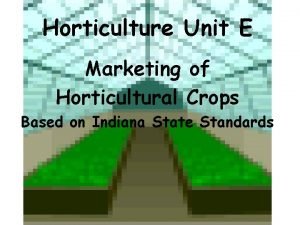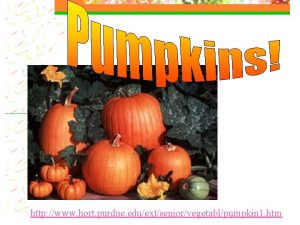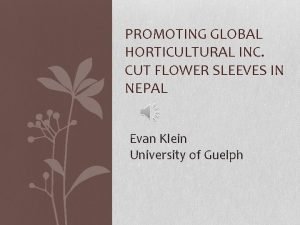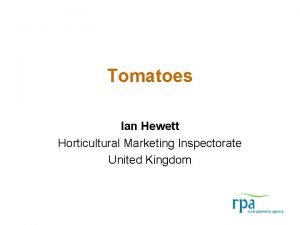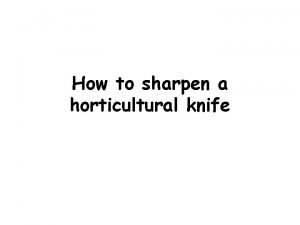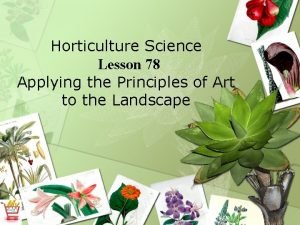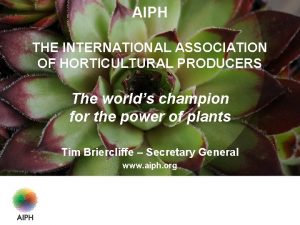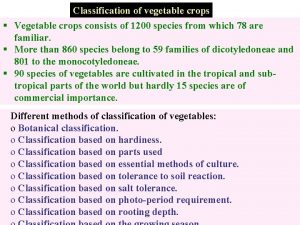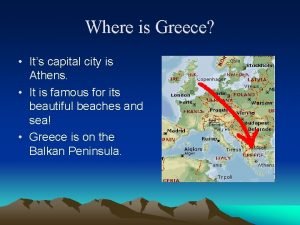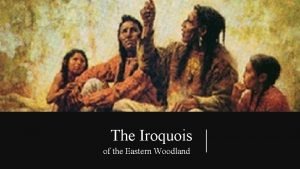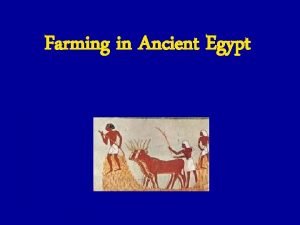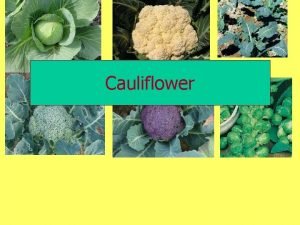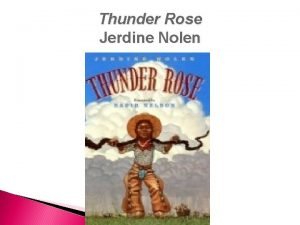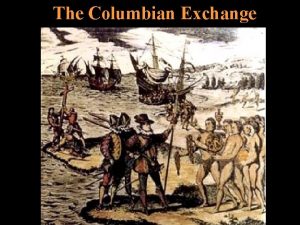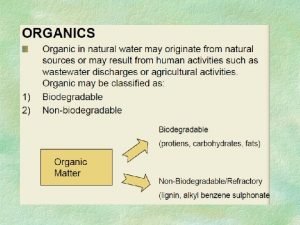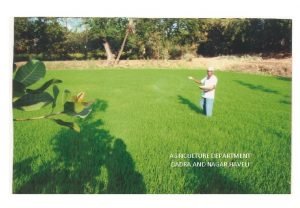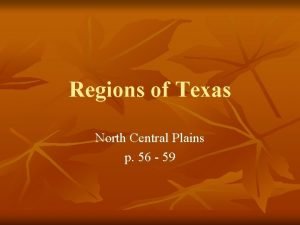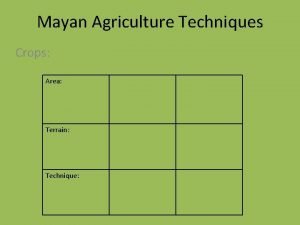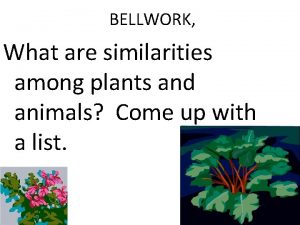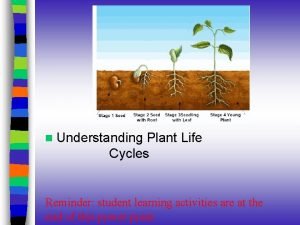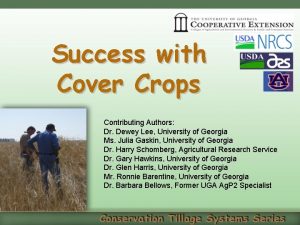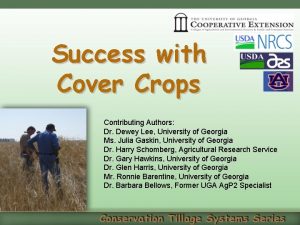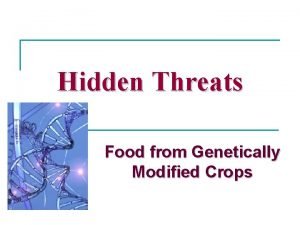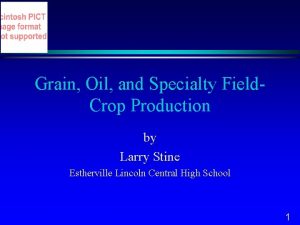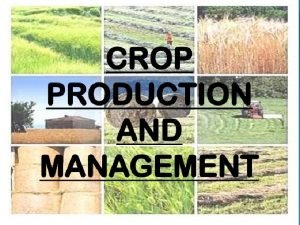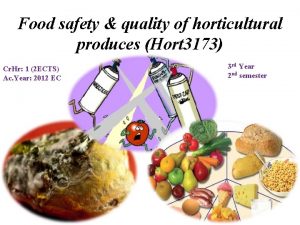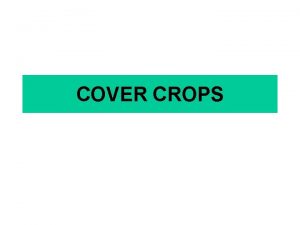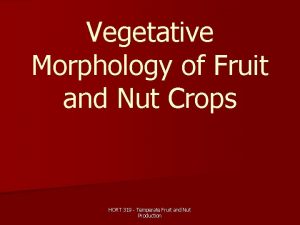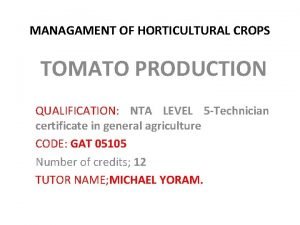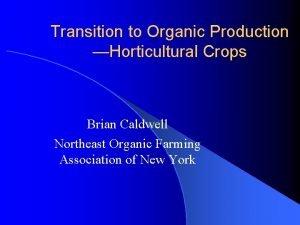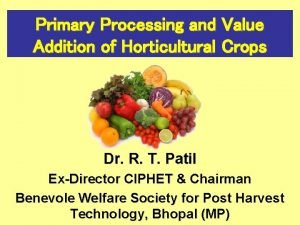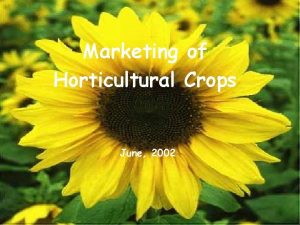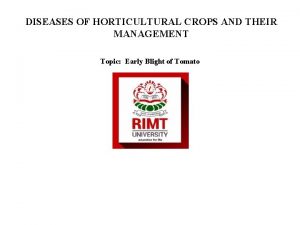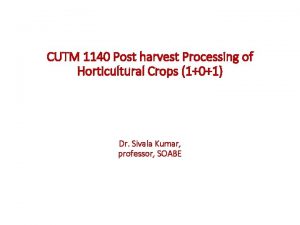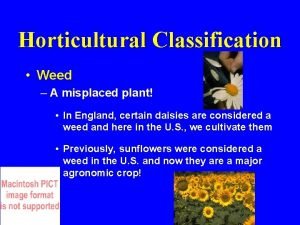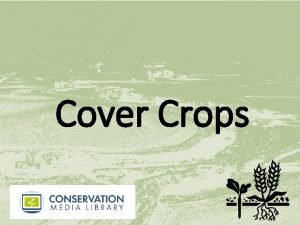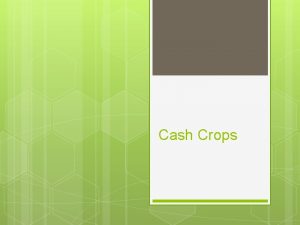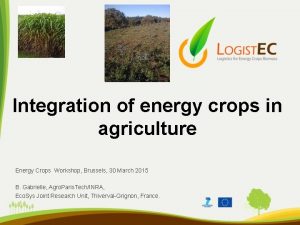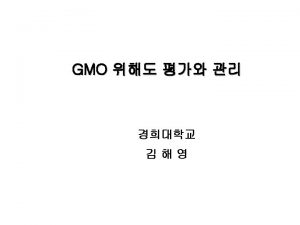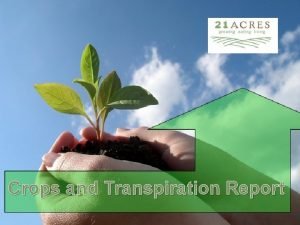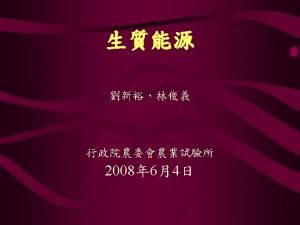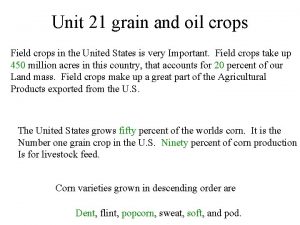Classification of Horticultural Crops Classification of Hort Crops

















































- Slides: 49

Classification of Horticultural Crops

Classification of Hort. Crops n Types of classification n Horticultural Botanical Horticultural Classification n Logically conceived systems n n n description nomenclature and identification of plants

Ways and Means of Classification n n n Growth habit and physiological characteristics Life span Flowering Habits Temp. relation Uses Morphology Cultural requirements

A. Growth habit & physiological characteristics n Succulents: n Plants with tender and watery stem & leaves n n Herbacious: n n Herb self supporting succulent tender stem either drooping or self supporting n n Foliage plants Most of vegetables Woody: n self supporting woody plants n Trees and shrubs

A. Growth habit & physiological characteristics n Classification of tree & shrub Tree Shrub Single central stem one or more stem Taller smaller May vary with environment and training practices. n n Plants with trailing/climbing stems woody/non-woody n n Non-woody stem Woody stem Vine Liana

A. Growth habit & physiological characteristics n Evergreen n n Plants with persistent leaves Tropical in origin E. g. , Citrus, mango, date, guava, litchi, coconut, olive, ber, banana, chiku, pineapple, fig and papaya etc. Deciduous n n Plant shedding their leaves in winter Eg. , Apple, pear, peach, plum, apricot, almond, cherry, strawberry, grapes, walnut, pistachio, pomegranate and falsa

B. Classification based on life span n Annuals n n n complete life cycle in one growing season. many vegetables and seasonal flowers. Biennials n n complete life cycle in two growing seasons. Ist season n n vegetative with short internodes and rosettes IInd season n bolting (sends up flowering stalk with long internodes bearing flowers and fruits) root vegetables (Carrot, beet, radish) n leafy vegetables (Lettuce and cabbage) n & onion. Climate is critical factor in determination of the life cycle Most of the above vegetables are treated as annuals ? n

B. Classification based on life span n Perennials n n Grow for years and woody. Growth n n Juvenile Mature (vegetative for several yrs. ) (veg. + reproductive) all fruit and ornamental trees and shrubs. Herbaceous plants like asparagus, potato & bulbs

Perennials n Winter Killing n n n Above ground parts killed Underground storage structures survive Brinjal and tomato n n perennial in tropical climate annual in temperate climate

C. Classification based on flowering habits Acc. to functionality of parts n Unisexual/imperfect n n Having one of the male/female floral parts on the flower Bisexual/hermaphrodite/perfect n Both male and female parts present on same flower e. g. peas. Acc. to presence/absence of floral parts n Complete flower. n n All four whorls present (Sepals, petals, stamens and pistils) Incomplete flower. n Anyone absent.

C. Classification based on flowering habits Acc. to availability of male/female parts on the plant n Monoecious: n n n Dioecious: n n n Male and female parts on the same flower/plant. e. g. , mango, citrus, cucurbits and walnuts. only one sex present on one plant. e. g. , Date and papaya, spinach, asparagus, beet Polygamous n n having all male, female and hermaphrodite flowers on the same plant Watermelon, fig, mango

D. Classification based on temperature relations n Temp. requirements for growth and tolerance to low temperature Acc. To growing season (Vegetables) n Summer n n grown year round in entire lower sindh-frost free area Winter n n Grown in plains of Punjab Easily cultivated in summer at high altitudes

D. Classification based on temperature relations Acc. To growing season (Vegetables) n Cool season crops n n Max. 80 -85°F Min. 35 -40°F Opt. 65°F Warm season crops n n n Opt. above 80°F Min. below 50°F (can’t grow) Frost sensitive

D. Classification based on temperature relations Acc. To growing season (Fruits) n n n Temperate: n Mostly deciduous. n Required chilling to flower n e. g. , apple, pear, plum and peaches. Sub tropical: n Can tolerate frost n e. g. , citrus, guava and grapes. Tropical: n More sensitive to low temp. n e. g. , banana, papaya and mango.

D. Classification based on temperature relations Acc. To growing season (Fruits) n Both tropical and sub tropical are n native to warmer climate, n frost sensitive, n needs hardening in late summer. According to ability to withstand low winter temperature. n n tender not resistant hardy resistant

D. Fruit Classification based on Uses & cultural requirements n Small or Soft fruit: n n n Nuts n n n Born on low growing plants like shrubs and vines grapes, falsa, strawberry edible seeds almond, walnut, pecans etc. Fleshy fruit n n soft flesh opposite to seed mango

D. Fruit Classification based on Uses & cultural requirements n Pome/False fruits n n n Berries n n n edible part thalamus apple, pear, quince. develop from ovary walls grapes, banana, citrus, tomato. Stone/drupe fruit n n fruits have stony endocarp. peach, plum, apricot, mango, cherry.

Quince

D. Fruit Classification based on Uses & cultural requirements n Multiple fruits n n n develop from many separate but closely clustered flowers Pineapple, fig, mulberry Aggregate fruits n n derived from a flower with more pistils on a common receptacle Individual fruit n n drupe (blackberry) Achene strawberry n Small one seeded indehiscent fruit developed from a single carpel

D. Vegetable classification based on uses & cultural requirements n Root crops with underground edible part n carrot, radish, turnip, beet, potato. n n Leafy vegetables n n lettuce, cabbage, celery, spinach Vine crops n Most of cucurbits

D. Vegetable classification based on uses & cultural requirements n Solanaceous fruits n n Flower crops n n Tomato, eggplant & bell pepper Cauliflower & broccoli Seed n Peas & beans

D. Ornamental plant classification based on uses & cultural requirements n Flowering plants n n Annuals, perennials and bulbs with underground storage organs. Landscape plants n n Foliage plants, ground covers, lawn grasses, hedges, trees and shrubs Indoor plants with persistent evergreen foliage

B. Botanical classification n n Scientific plant classification based on phylogenetic relationships of organisms. Taxonomy : Greek word n n Taxon group/category Science of classification Class. On the basis of diff. and similarities Mid 18 th Century, C. Linnaeus used n n morphology of sexual/reproductive parts as basis for taxonomy b/c these organs are less influenced by env.

n n n n Kingdom Division Class Order Families Major taxa Genus Species Variety/strain (minor taxa)

B. Botanical classification n Plant Kingdom n n Includes a dozen major phyla/divisions Tracheophyta is more developed n n Have vascular/treachery system (common in all higher plants) All hort. crops except mushrooms Several classes Hort. Important classes n n n Filicinae (ferns) Angiospermae (flowering plants) Gymnospermae (conifers)

B. Botanical classification n Gymnosperms n n n Naked Seeds Small group (~700 living sp. ) Mostly evergreen with needle shaped leaves. Belong to temperate zone. Sources of timber, wood pulp, turpentine, resins, edible seeds and high value ornamental plants.

B. Botanical classification n Angiosperms n n n Seed enclosed in fruit Large group of plants (> 25000 sp. ) Broad leaves Primary source of food, fiber & shelter Sub-classes n n Dicotyledonae Monocotyledonae

B. Botanical classification n n Dicots (200, 000 sp. ) n 2 cotyledon n floral parts in 4/5 multiples. n Leaf venation reticulate n Presence of vascular cambium Monocots (50, 000 sp. ) n single cotyledon n Floral parts 3 or multiple n Both classes have several orders and families n Vascular cambium is absent

B. Botanical classification n Identification and description n n Based on two parts, Generic (capital letter) Specific (small) Genus n n group of species with common morphological, genetic and cytogenetic features. Specie n n Plants morphologically same and produce like progeny Normally inter-breeding population.

n n n Variety: When a population of plants within a species differ in appearance from the original members of species Cultivars: Refers to a named group of plants within a cultivated species which maintain their identity when propagated either sexually or asexually Clones: A population propagated vegetatively from single original stock Strain or sport: A variant among a clone.

B. Botanical classification n Varietal name follows the specific name. n n n Cultivar n n Brassica oleraceaea botrytis (cauliflower) Brassica oleraceaea capitata (cabbage) Group of plants within cultivated specie that maintain the identity when propagated sexually or asexually. Sexually propagated cultivar categories: n n n Pure line or self-pollinated Open-pollinated (OP’s) Hybrids

THANKS ANY QUESTIONS

Next lecture n Present status and future scope of hort. (assignment)

n n n Area, production, yield/hec, exports data of major fruit and vegetables Source: Agri. Stat. of Pakistan FAO production year book Economic survey of Pak. Hort. Dev. Export Board PHDEB.






n n n n Present status and future scope of Horticulture In pakistan 8 -10% area is under Horticulture. Problems are, shortage of water PH increase population industerial area prosperity

n Need for significance increase in production: n n n INCREASE AREA UNDER HORTICULTURE INCREASE PER ACRE PRODUCTION DECREASE AREA UNDER OTHER CROPS DECREASE THE PH LOSSES. Factors limiting the growth of Horticulture: The last few years through the production has increase rapidly and still we

n n n Nurseries: Private nurseries have no law e. G fruits Rootstock mother plant. Decrease of bud wood No check on pedigree No check on freedom from diseases.

n n n Farmer hesitate fruits b/c long term investment Marketing uncertainties especially in vegetables Profit oriented Farmers attention is negligible Needs incentives and capital infra structure Marketing system





THANKS ANY QUESTIONS

Next lecture n Significance of Hort. Contd.
 Horticultural crops classification
Horticultural crops classification Marketing of horticultural crops
Marketing of horticultural crops Hortplus
Hortplus Hort purdue
Hort purdue Sven hort
Sven hort Simple horticultural societies
Simple horticultural societies Global horticultural inc
Global horticultural inc Simple horticultural societies
Simple horticultural societies International horticulture society
International horticulture society Specific gravity of fruits and vegetables
Specific gravity of fruits and vegetables Horticultural marketing inspectorate
Horticultural marketing inspectorate International society for horticultural science
International society for horticultural science Horticultural technician apprentice
Horticultural technician apprentice Horticultural knife
Horticultural knife Applied principles of horticultural science
Applied principles of horticultural science International association of horticultural producers
International association of horticultural producers Features of industrial society
Features of industrial society Botanical classification of vegetable
Botanical classification of vegetable The capital city of greece
The capital city of greece Subsistence tendon
Subsistence tendon Crops and their scientific names
Crops and their scientific names Ancient egypt agriculture
Ancient egypt agriculture Cole crops definition
Cole crops definition My crops doing well
My crops doing well Pictures of food crops
Pictures of food crops Kayla antoniou
Kayla antoniou Crops
Crops Agri chemicals projects in dadra & nagar haveli
Agri chemicals projects in dadra & nagar haveli Why do kat and peeta decide to talk on the roof?
Why do kat and peeta decide to talk on the roof? North central plains location
North central plains location Mayan agricultural techniques
Mayan agricultural techniques Mexican crops
Mexican crops Golden crops foe
Golden crops foe Because you speak english unnaturally
Because you speak english unnaturally Spatial arrangement of crops
Spatial arrangement of crops Warm season crops
Warm season crops The jumano built villages and grew crops near the
The jumano built villages and grew crops near the Where to find nitrogen
Where to find nitrogen Life cycle of perennial plants
Life cycle of perennial plants Catch crops examples
Catch crops examples Golden crops foe
Golden crops foe Expected outcomes in research examples
Expected outcomes in research examples Farmer plants different crops in a field each year
Farmer plants different crops in a field each year Cover crops
Cover crops Cover crops
Cover crops Genetically modified crops have
Genetically modified crops have The primary harvesting machine for field crops is the:
The primary harvesting machine for field crops is the: Disadvantages of potato
Disadvantages of potato Genetically modified crops have
Genetically modified crops have Kharif crops list
Kharif crops list

